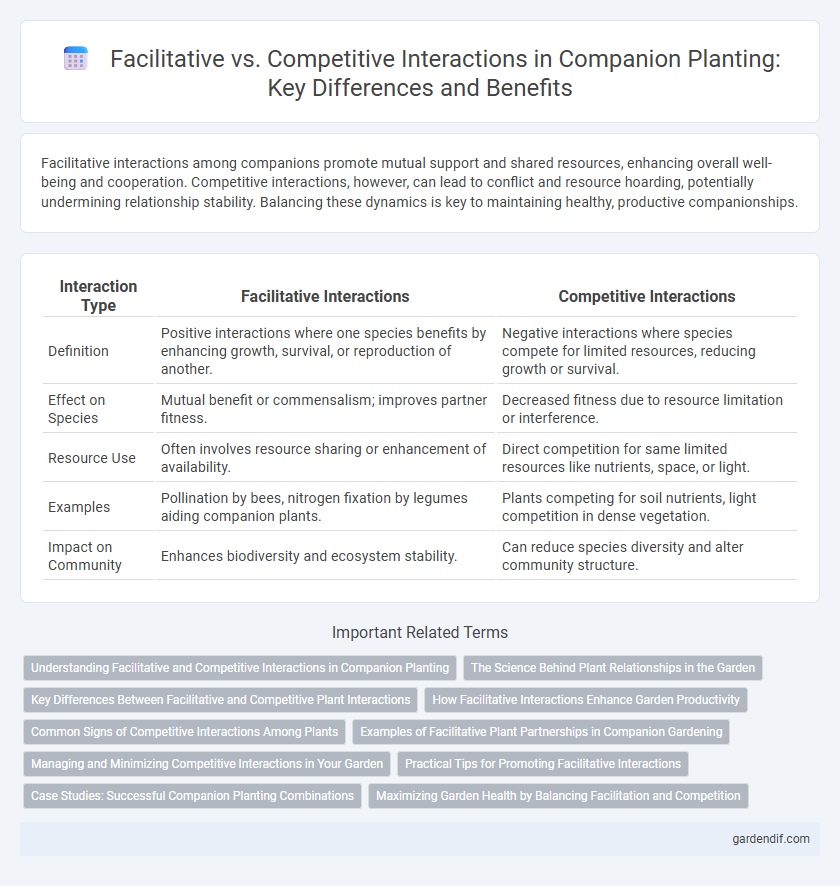
Facilitative interactions vs competitive interactions Illustration
Facilitative interactions among companions promote mutual support and shared resources, enhancing overall well-being and cooperation. Competitive interactions, however, can lead to conflict and resource hoarding, potentially undermining relationship stability. Balancing these dynamics is key to maintaining healthy, productive companionships.
Table of Comparison
| Interaction Type | Facilitative Interactions | Competitive Interactions |
|---|---|---|
| Definition | Positive interactions where one species benefits by enhancing growth, survival, or reproduction of another. | Negative interactions where species compete for limited resources, reducing growth or survival. |
| Effect on Species | Mutual benefit or commensalism; improves partner fitness. | Decreased fitness due to resource limitation or interference. |
| Resource Use | Often involves resource sharing or enhancement of availability. | Direct competition for same limited resources like nutrients, space, or light. |
| Examples | Pollination by bees, nitrogen fixation by legumes aiding companion plants. | Plants competing for soil nutrients, light competition in dense vegetation. |
| Impact on Community | Enhances biodiversity and ecosystem stability. | Can reduce species diversity and alter community structure. |
Understanding Facilitative and Competitive Interactions in Companion Planting
Facilitative interactions in companion planting involve plants supporting each other's growth by improving nutrient availability, pest resistance, or microclimate conditions, such as nitrogen-fixing legumes enriching soil for neighboring crops. Competitive interactions occur when plants vie for limited resources like water, sunlight, and nutrients, potentially hindering each other's development and reducing overall yield. Understanding the balance between facilitative and competitive interactions enables gardeners to optimize plant combinations, enhancing productivity and ecological sustainability.
The Science Behind Plant Relationships in the Garden
Facilitative interactions among plants enhance growth by improving resource availability, such as nitrogen fixation by legumes enriching soil fertility for neighboring crops. Competitive interactions occur when plants vie for limited resources like water, light, and nutrients, potentially stunting growth and reducing yields. Understanding these mechanisms allows gardeners to optimize companion planting strategies, promoting healthier, more productive garden ecosystems.
Key Differences Between Facilitative and Competitive Plant Interactions
Facilitative plant interactions enhance growth and survival by providing mutual benefits such as improved nutrient availability, shade, or protection from herbivores. Competitive plant interactions involve rivalry for limited resources like light, water, and nutrients, often leading to suppressed growth or dominance of one species. Key differences include facilitation promoting coexistence and diversity, while competition tends to reduce resource access and may result in competitive exclusion.
How Facilitative Interactions Enhance Garden Productivity
Facilitative interactions in companion planting improve garden productivity by creating mutually beneficial relationships between plants, such as nitrogen-fixing legumes enhancing soil fertility for neighboring crops. These positive interactions reduce pest pressure and improve resource utilization, leading to healthier plants and higher yields. Enhanced microclimates and improved pollinator attraction further boost overall garden efficiency compared to competitive interactions.
Common Signs of Competitive Interactions Among Plants
Common signs of competitive interactions among plants include stunted growth, reduced leaf size, and uneven resource distribution, which result from intense competition for light, water, and nutrients. Indicators such as root overlap, shadowing by taller plants, and leaf chlorosis reveal the struggle for essential resources. These competitive pressures often lead to decreased biomass and lower overall plant health in densely populated areas.
Examples of Facilitative Plant Partnerships in Companion Gardening
Facilitative plant partnerships in companion gardening include the classic pairing of beans and corn, where beans fix nitrogen to enrich soil for corn growth. Another example is marigolds planted alongside tomatoes to repel nematodes and improve tomato health. Basil and peppers also demonstrate facilitative interactions, as basil enhances pepper flavor and deters insect pests naturally.
Managing and Minimizing Competitive Interactions in Your Garden
Managing competitive interactions in your garden involves strategic companion planting to enhance resource sharing and reduce plant stress. Using facilitative interactions such as nitrogen-fixing legumes alongside nutrient-demanding plants improves soil fertility and minimizes competition for nutrients. Employing mulching and targeted watering further supports plant health by reducing competition for water and suppressing weed growth.
Practical Tips for Promoting Facilitative Interactions
Encouraging facilitative interactions among companions involves fostering open communication, active listening, and mutual respect to build trust and collaboration. Practical strategies include creating shared goals, promoting empathy through perspective-taking exercises, and recognizing individual strengths to enhance group cohesion. Regular feedback sessions and conflict-resolution training can also minimize competitive behaviors and support a cooperative environment.
Case Studies: Successful Companion Planting Combinations
Case studies of companion planting reveal that facilitative interactions, such as nitrogen-fixing legumes paired with nitrogen-demanding crops, enhance nutrient availability and crop yield. In contrast, competitive interactions often occur when plants with similar resource requirements, like sunflowers and tomatoes, compete for sunlight and soil nutrients, reducing overall productivity. Successful companion planting combinations, such as corn, beans, and squash in the traditional Three Sisters system, demonstrate optimized plant growth through complementary resource use and pest control.
Maximizing Garden Health by Balancing Facilitation and Competition
Maximizing garden health requires balancing facilitative and competitive interactions among companion plants to optimize resource use and minimize stress. Facilitative interactions enhance nutrient uptake, pest resistance, and microclimate conditions, while controlled competition ensures efficient space utilization and limits dominant species overrunning others. Strategic planting that combines nitrogen-fixing legumes with deep-rooted crops exemplifies this balance, promoting robust growth and sustainable garden ecosystems.
Facilitative interactions vs competitive interactions Infographic

 gardendif.com
gardendif.com